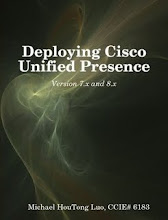With more and more network equipments move to open source OS (linux) and x86 platform, the word 'simulator' has another meaning - virtualization. Which means, you can run the software (such as IOS, JUNOS, etc.) on a x86 computer just like it runs on the original hardware.
I still remember the excitment when I discover that I can run JUNOS on a 486 PC back in 1999. I built my first JNICE lab with nine of those PCs ($50 each).
Now, working in Cisco Unified Communication team, one of the challenges I'm facing is the availability of equipments. Sure we have access to IP phones, routers and switches. But getting mobile phones (BlackBerry, Nokia, WinMobile, Android, iPhone) and ASA (Adaptive Security Appliance) for each engineer is not as easy as we thought.
Mobile phones are required to test CUMC (Cisco Unified Mobile Communicator). ASA is required to test CUMA (Cisco Unified Mobility Advantage), Phone Proxy and CUPS Inter-domain Federation.
Fortunately, with simulators, everything can be run on a PC (or a virtual machine).
Below is a BB simulator and ASA simulator running on a VM.

When running a network appliance image (such as JUNOS or ASA) on a PC or VM, one thing to notice is that you cannot use the monitor and keyboard as console. Why? Because a router does not have video card and keyboard. The 'console' port is the serial port.
If you are using a PC, connect the console cable to the COM port.
If you are using a VM, you may direct the serial output to a named piple.

For the VM that running the appliance image (such as JUNOS or ASA), set the 'near end' to 'Server'. Set the 'far end' to 'A Virtual Machine'. You may use any name for 'pipe name'.
For the VM that acting as 'terminal' (such as WinXP or Linux), set the 'near end' to 'Client'. Set the 'far end' to 'A Virtual Machine'. The 'pipe name' needs to match the one you configured above. After this, it's like there's a serial cable connects the terminal VM(WinXP) and the appliance VM (ASA).


Thanks to VMware, I run the Call Manager 6, Windows 2003, Asterisk and others in my personal lab.
ReplyDeleteHi,
ReplyDeleteCan you please provide a little more installation regarding how you installed the Cisco Unified Mobile Communicator on the Blackberry?
Click the link ('BB') in my blog and download the simulator from BlackBerry.com.
ReplyDeleteThanks for the info. Just what I need to complete the last bits of my UC 7 Lab.
ReplyDeleteWhen deploying blackberry with CUMC. Did you also configure the Black Berry Enterprise Server ?
ReplyDeleteBES (Business Enterprise Server) is optional, unless you want to be a BES guru. :)
ReplyDeleteThank you Michael for this nice post.
ReplyDeleteI need to install ASA to integrate with CUMA but what I know is to integrate CUMA with ASA we need ASA 8.0.4 and later and what I know is no way to run ASA 8.0.4 on Pemu. I tried to run it using VMware but I could not it is not clear in this site:
http://asa_project.gromnet.net/?p=33
but there is no clear information about the type of VMware steps to install shall i install OS or not
can you help me or give a link for this?